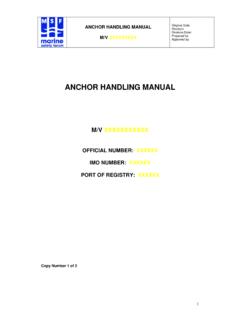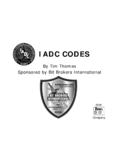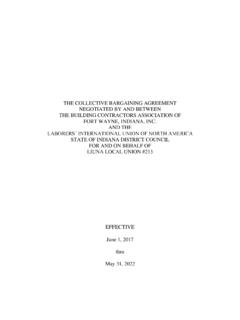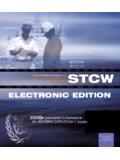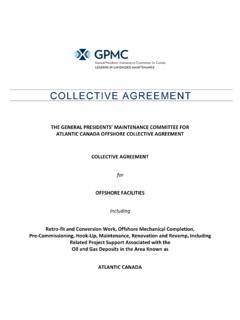Transcription of International guidelines for the safe operation of ...
1 International guidelines for The Safe operation of dynamically Positioned offshore supply Vessels 182 MSF Rev. 2 April 2015. International guidelines for The Safe operation of dynamically Positioned offshore supply Vessels Rev. 2 April 2015. These International guidelines have been produced by a cross-industry workgroup. Its secretariat has been provided by IMCA the International Marine Contractors Association which is also making the guidelines available as part of its publications service. For this purpose, the guidelines may be referred to as 182 MSF. IMCA. 52 Grosvenor Gardens, London, SW1W 0AU, UK. Tel: +44 (0) 20 7824 5520. Fax: +44 (0) 20 7824 5521. E-mail: Web: The information contained herein is given for guidance only and endeavours to reflect best industry practice. For the avoidance of doubt no legal liability shall attach to any guidance and/or recommendation and/or statement herein contained.
2 International guidelines for the Safe operation of dynamically Positioned offshore supply Vessels Preface Reliable and robust methods of positioning are required for safe vessel operations in close proximity to offshore installations. Dynamic positioning (DP) is well established as a primary method of vessel positioning, in the diving, drilling, construction, accommodation and shuttle tanker sectors, and it is especially suited to deep-water developments. As development and management of DP becomes more refined, increasingly logistics support vessels are becoming equipped with DP systems with increasing reliance being given to such systems. Accepted industry guidance that forms the basis of safe DP operations is the International Maritime Organization (IMO) guidelines for vessels with dynamic positioning systems.
3 DP operators should also refer to the relevant DP rules of the main classification societies and all appropriate IMCA and Marine Technology Society (MTS) documents. Such rules and guidelines are focused principally on design, construction and operation of DP vessels and, in particular, apply the principles of redundancy in creating a hierarchy of DP equipment classes. They also set generic requirements for the verification of DP systems, including DP failure modes and effects analyses (FMEA). survey and testing procedures, as well as requirements for vessel operators to develop appropriate operating instructions. There are also internationally recognised standards for DP training, which are set out in IMO . guidelines for dynamic positioning system (DP) operator training. That document recommends the use of IMCA.
4 M 117 The training and experience of key DP personnel ( International Marine Contractors Association (IMCA)). In addition, the 2010 amendments to the IMO International Convention on Standards of Training, Certification & Watchkeeping for Seafarers (STCW) Code introduced new guidance on the training and experience of personnel operating DP systems. Other training guidance can be found, for example, in the Nautical Institute certification programme. All of these documents are augmented by a range of DP related guidance from IMCA. In addition to these industry rules and guidelines , the day to day operation of a DP vessel is considered a critical operation and is therefore being managed by vessel operators as part of their safety management system. In addition, individual charterers have specified their own requirements to safeguard the integrity of their own offshore installations.
5 National and regional requirements are also in force. Whilst reflecting the existing industry framework, the guidelines contained in this document provide vessel operators, charterers, masters and officers with sector-specific methods for the safe operation of DP offshore supply vessels. These guidelines were originally drawn up by an International cross-industry workgroup, and have recently been updated by the Marine Safety Forum in conjunction with IMCA and the guidelines for offshore Marine operations (GOMO) Group. This document is published by IMCA but with an MSF reference (182 MSF) as it does not necessarily reflect guidelines given in other IMCA documents. The intention is that this document will provide guidance, when DP is to be used on an offshore supply vessel , which is suitable for International application.
6 This document is to be revised every three years unless necessity requires a shorter review period. Cross-Industry Workgroup Circulation List Atlantic Towing Blade offshore Services BP Exploration Operating Company Braemar Engineering (Wavespec). C-Mar (Americas). DNV GL. ExxonMobil Development Company Farstad Shipping GOMO (Guidance for offshore Marine operation ) Group IMCA International Marine Contractors Association Island Terminals L-3 Communications Maersk Oil North Sea Maersk supply Service Maritime and Coastguard Agency McDermott International MSF Marine Safety Forum Nederlandse Aardolie Maatschappij Noble Drilling Services OCIMF Oil Companies International Marine Forum OMSA offshore Marine Services Association OSVDPA offshore Support Vessels DP Authority Pemex Petrobras Sealion Shipping Shell Global Solutions International Swire Pacific offshore operations Technip The Dynamic Positioning Centre Tidewater Total Exploration & Production Transocean US Coast Guard International guidelines for the Safe operation of dynamically Positioned offshore supply Vessels April 2015.
7 I 1 Introduction .. 1. Basis of these guidelines .. 1. Application of these guidelines .. 1. Purpose and Scope .. 1. Abbreviations .. 2. Terms and Definitions .. 3. 2 Existing Rules and 5. International Rules and Guidance .. 5. Flag State Verification and Acceptance Document (FSVAD) .. 5. Classification Societies .. 6. Regional Rules and Guidance .. 7. DP System and Verification .. 7. 3 Managing Risk in DP operations Competence .. 9. Key DP Personnel Competence Training and Certification .. 9. DP offshore supply vessel Manning .. 12. 4 Managing Risk in DP operations operations .. 13. DP offshore supply vessel Capability .. 13. Guidance on Activity-Based Operational Planning .. 15. Critical Activity Mode of operation .. 17. Activity Specific Operating Guidance .. 18. Guidance on the Application of CAMO, TAM and ASOG.
8 19. DP operations Manual .. 21. List of DP Operational Procedures .. 22. DP Incident 26. 5 Managing Risk in DP operations Practical Application .. 27. Appendices 1 Relevant Publications .. 28. 2 DP FMEA and Annual Trials .. 29. 3 Annual DP 32. 4 DP Capability Plot .. 33. 5 DP Footprint Plot .. 35. 6 DP vessel Specific Location Checks Document .. 37. 7 Sample DP Watchkeeping Handover Checklist .. 40. 8 DP Incident Reporting .. 42. 9 Example of Critical Activity Mode of operation (CAMO) .. 44. 10 Example of Activity Specific Operating Guideline (ASOG) .. 47. 1 Introduction Basis of these guidelines These guidelines are based on the specific characteristics of DP equipped offshore supply vessel operations . In particular, unlike many other DP vessel operations , offshore supply vessels can, under normal operating circumstances: i) Terminate supply operations and move away from the offshore installation at a moment's notice; and/or ii) Safely manoeuvre through the use of independent joystick or manual' control whilst supply operations are being carried out.
9 Such operations are usually only of short duration. It should be noted, however, that the above may not be possible when handling bulk cargo through hoses whereby safe disconnection times should be taken into consideration. Furthermore, as offshore supply vessels routinely operate in close proximity to offshore structures and therefore pose a significant collision risk, all supply operations close to such structures should be considered as critical activities. Application of these guidelines These guidelines primarily apply to DP equipped offshore supply vessels, but may also include all other types of vessels carrying out supply and other ancillary operations (usually accepted as cargo, anchor- handling and towing operations ), subject to section (i) and (ii) above, when in DP mode either inside or outside of the 500 metres safety zone of an offshore installation.
10 These guidelines do not preclude non-DP-equipped vessels from carrying out supply operations but merely offer guidance for those using DP. Acceptance of the limitations of vessels and decisions on suitability of DP use inside installation safety zones shall always lie with the charterer. Purpose and Scope The purpose of these guidelines is to make risk management tools available to vessel operators, charterers, masters and officers that will help ensure safe operation of DP offshore supply vessels in automatic DP mode. These guidelines fit into an existing framework of rules and guidance issued by various authorities and organisations. Efforts have been made to ensure compatibility with the existing documents wherever possible. It is recognised that both the DP and offshore supply vessel sectors are constantly evolving.



